
|
Note ye ed's email address: stevebryant99@gmail.com. |

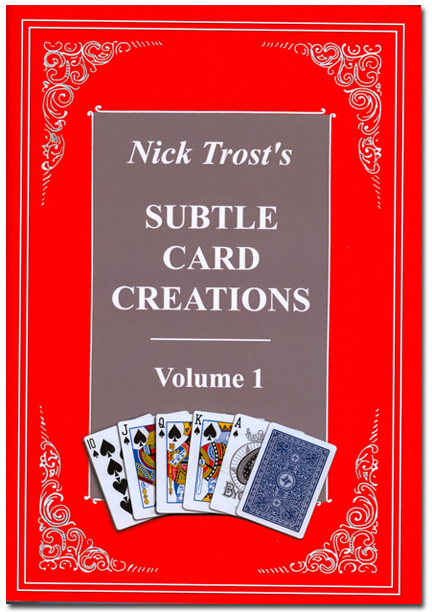
At 7 and counting: the book that started it all.
|
Return to our March 2019 issue to consider consider the hit Broadway play Network and producer Sandy Marshall, NBA coach Bob Weiss, and bid farewell to Johnny Thompson, Gary Darwin, Steve Dusheck, James Hodges, and Marshall Brodien. |
April 2019 It is amazing that the same guys can fool me with an April Fool's gag year after year. ESPN's sportscasters Tony Kornheiser and Michael Wilbon opened their post-Final Four broadcast with the news that college basketball superstar Zion Williamson might return to Duke rather than going pro and being drafted by the knicks. They argued this outrageous notion for five minutess before saying, "Are you going to tell them? April Fool!" It wasn't magic, but it definitely fooled me. This month we take a sneak peek at Nick Trost's Subtle Card Creations Volume 7 and an H&R farewell peek at The Little Egypt Book of Numbers, spend some time with the members of The Buena Vista Shuffle Club (Matt Baker's new book), and turn back the clock to the magic I encountered at ten years old. We close with a nostalgic look at who was playing at the magic Castle in 1979, courtesy of Erika Larsen. It really was a golden age, during one of my last full years of living in southern California. |
|
|
EVERYTHING MUST GO SALE -- This is a bittersweet book review. On April 16, Marshall Peterson, along with Richard Hatch and Charlie Randall, announced that H&R Magic Books would be closing its bookshop doors. The good news is that Charlie Randall plans to keep on publishing, especially Volumes 7-9 of the Nick Trost series. The great news is that Volume 7 is at the printers. Once again, Nick Trost favors magicdom with essential, compelling card magic, the seventh (of a projected nine) in his Nick Trost's Subtle Card Creations series. It's another fine outing with much to admire, some 100 card tricks that play out over 11 chapters, namely Unique Card Effects, More Amazing Coincidences, Court Cards, More Poker Puzzlers, Gambling Tricks, Baffling Revelations, Gilbreath Plays Poker - Part 4, Transpositions, More Triple Dealing Effects, ESP Tests, and Miracles with Cards. 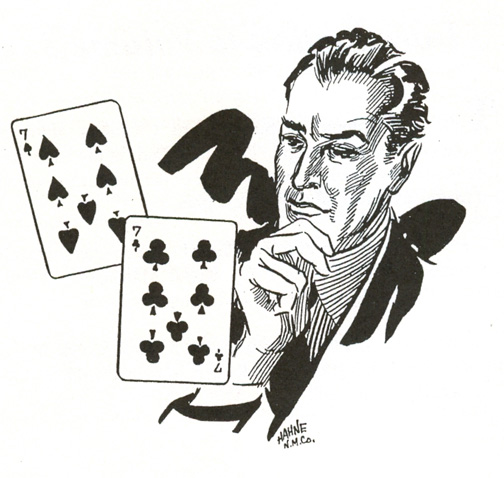 Vintage illustration from Volume 3. I particularly enjoyed: All Backs Royal Flush. You cleanly display five cards with backs on both sides. Following a through the fist flourish, the cards morph to a royal flush with faces. And the trick cleans up nicely. Fun to watch. Blackjack Lesson. A nutty plot but fun to watch and easy to perform. Show four cards as two pairs of red tens. A score of 20 each, not good enough in blackjack. The four cards change to two blackjack hands, each an AS and a JS. But you are a poker player, so the cards change to five jokers. 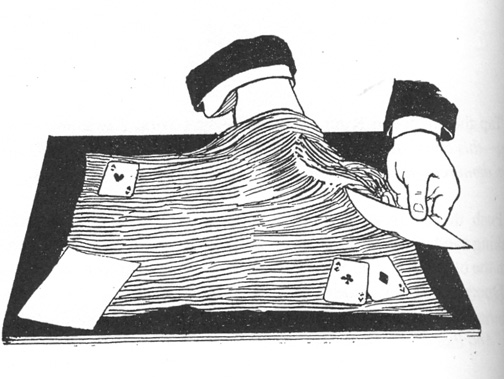 Vintage illustration from Volume 3. One of my favorites of the entire series was Shuffle Tracking, from Volume 3. Via a poker deal involving 25 cards, the magi deals two, three, four, six, seven, or eight hands, at spectator request. (This is repeated as desired, the sequence owing to Roy Walton.) The dealer receives a royal flush, his opponents receive four pat hands named through amusing insider poker lingo. Volume 7 explores further variations. Shuffle Tracking a Royal Flush begins by extracting a royal, then controlling it despite the two through eight hands, the other players receiving 9 to 5 straights. Shuffle Tracking Another Version is similar to the Volume 3 effect, the dealer eventually getting a straight flush and the others four strong pat hands. A Draw Poker Demonstration "mixes" the cards via the Walton procedure, then ends by causing the players to draw cards to fill strong hands a la the Vernon Poker Demonstration. Even Odder. Bro. John Hamman's Odd-Even-Odd is a longtime favorite and used to be part of my regular repertoire. Nick supplies an easy and effective version. Odd and even spot cards trade places, but the odd cards become "more odd" as they turn into court cards. Total Coincidence with One Deck. If you like Juan Tamariz's two-deck version from Sonata, you should love this one-deck version. Ten-Hand Poker Deal and Repeat. This routine is a close cousin to Allan Slaight's excellent Heavy Breather. It seems impossible. I'll resort to the actual text: The performer removes the four aces and the KH, explaining that he will demonstrate “shuffle tracking” with these five cards. A spectator shuffles the rest of the deck, which is then divided into five packets. The four aces and the KH are inserted into the five packets. Each packet is shuffled by running cards in a random fashion at the spectator’s discretion. The spectator dictates how many cards are run in each packet. The packets are stacked in any order, then dealt into ten poker hands. The performer predicts which hand the aces and KH will fall in—and he is correct! The tenth hand—the performer’s—is the winner. It contains a straight flush in spades. The effect is repeated with the spectator losing the straight-flush cards in the deck himself. Again ten hands are dealt, and the performer ends up with the straight flush in the tenth hand! Ace to Five. A very easy version of the ambitious-type five-card trick in which the ace through four of spades rise to the top, then the five of spades turns into the five of hearts. What knocks this into orbit is that you are left dirty with a reversed card, and you clean that up via a strong card discovery trick. Separating the Men from the Boys. Another visual, fun to watch effect. Four kings and four jacks (men and boys) alternate. Two boys and two men are dealt to the table. But suddenly the cards in your hand are all kings, and those on the table are ... queens! In Phase 2, the four jacks reappear and are placed on top of four piles. Suddenly, they all congregate on one pile and are set aside. The top cards of the piles turn out to be the four kings who unite with a queen of each suit to form four royal marriages. Enough! I could go on and on and easily highlight many more effects. Volume 7 contains all the familiar elements from the previous six installments: Nick Trost's refreshingly straightforward technical writing, copious illustrations by Tony Dunn and decorative vintage line art, dead-on epigraphs, precision editing by Charlie Randall, and of course over 100 baffling, easy-to-do card tricks. There is a foreword by Richard Vollmer and an introduction by Nick Trost. Beautifully packaged by H&R Magic Books, 221 pages plus frontal matter, hardback with dust cover. Expected price tag: $50. BONUS REVIEW -- Given that H&R Magic Books is closing its doors, this may be your last opportunity to purchase The Little Egypt Book of Numbers directly from the publisher and at a bargain price. As I have indicated before, we mis-titled the book (the "Numbers" refers to the fact that a number is embedded in each trick title, such as Catch-22, Love Potion Number 9, Duffie Deep-Sixed, etc.). We should have titled it The Little Egypt Book of Killer Bar Magic, because that is what it is, extremely strong material that I developed for use over two decades at Smith and Groves tavern in Cairo, Illinois. 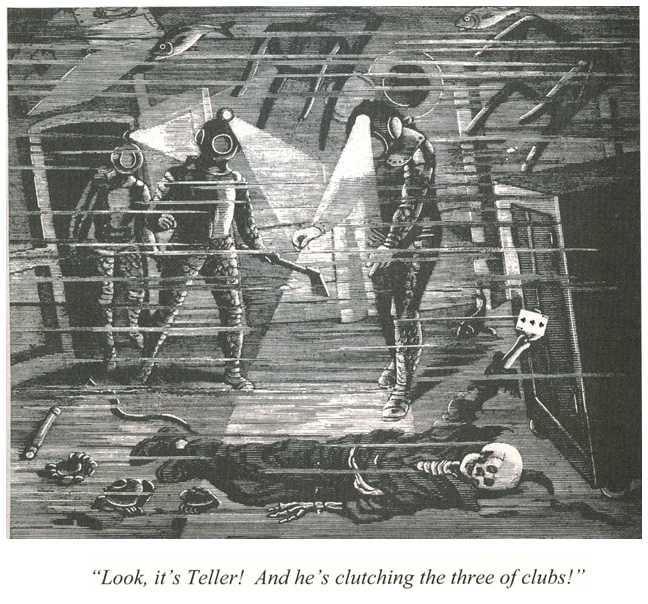 From The Little Egypt Book of Numbers. 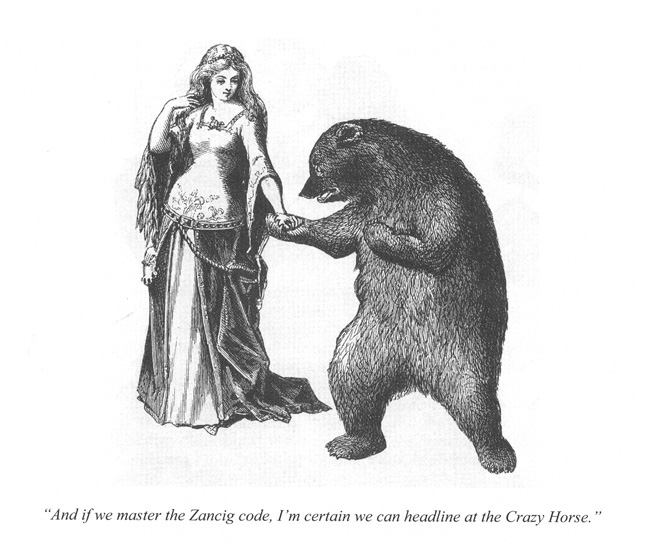 From The Little Egypt Book of Numbers. As previously boasted, "There are items that should baffle anyone, items that get people wet, items that are sexy, items that are seriously frightening, one that will get you kissed, and one that might result in your mom washing your mouth out with soap." You can find H&R's take on it here, for the time being. hardbound, dust cover, 20 items, 128 pp., $35 originally, prices dropping. H&R also stocks individual issues of Genii to which I contributed cover stories or other feature stories for 40 years. We summarized these in Little Egypt Magic back in September 2010. Find what you want and check with H&R for availability. Or go to the H&R web site and search on my name. Regrettably, The Little Egypt Book of Ghosts is no longer in stock. |
|
|
MAGIC FOR SMARTIES (AND THE REST OF US) -- I first learned of Matt Baker's new book at Magi-fest, when Matt overheard Mike Powers and I discussing Euler's identity (a quirky equation that appears in Principia). This of course would catch the attention of a Georgia Tech math professor, which Matt is, not to mention his having also been a contestant on "Jeopardy!" and a resident student of Juan Tamariz. It's hard to say which is the most impressive! Said book is The Buena Vista Shuffle Club, with some of the most intriguing math-oriented card (and coin) material since the Diaconis/Graham Magical Mathematics. The book is named for a fictional trio of card guys, cast as friends of Matt Baker, each with his own back story, who kibitz at the end of most tricks and, in sections called Variations, contribute full routines of their own. It's a delightful conceit, similar to how John Bannon discusses tricks in his own books, and addictive. You want to join the conversations.  Awesome debut magic book. I purchased the book despite knowing that I couldn't do much of the material, as over 100 pages deal with memorized decks, not my thing. But I expected and found interesting uses for that tool plus plenty more that I could embrace. A few instances (from self-working to stuff that will fry your brain): Card College. Undergrad: Spectator hands you about half a deck and you tell him exactly how many cards you have. Master's degree: Spectator shuffles the two halves together. He puts half in his pocket, hands you half of the remainder, and puts the rest in the card box, all while you do not look. You tell him how many are in his pocket. Doctorate: You name each card in the box. Despite that legit shuffle, a memorized deck makes it possible. Clue. A full-blown stage/parlor routine based on the board game Clue involving six spectators on stage. You predict the murderer, the weapon, and the location. If I could join the conversation, I would probably raise eyebrows by suggesting you add a stooge and advise him to write "Taj Mahal" (or whatever the force location is). Rationale on request. Histed Hoisted. The Shuffle Club guys submit a version of Simon Aronson's Histed Heisted, itself a Princess-type classic, extending to it the possibility of using a memorized deck. Whatever method you use, this is a strong effect. For the record, I contributed three methods to The Little Egypt Book of Numbers titled Chandu, the Mindreader, Plays Five-Card Draw. They range from a one-deck impromptu version to a multi-climax two-deck version. No memorization or crib sheet is required, and there are several one-degree bits to enhance. Banned for Life. With roots in Simon Aronson's Shuffle-Bored, this is a blackjack card counting routine in which the card are chaotically mixed face-up/face-down, yet the magi keeps track of how many are face up, how many of those are black, and the running total of the values of the black cards. Hive Mind. Shades of "Stranger Things." The group fills in a Mad-libs like prediction of how many coins each of two spectators will have, and the prediction comes true despite the group making all the decisions. Of all the tricks in the book, this is the one I am most likely to perform. Pile Driver. This is one I won't be doing. I am in awe because it is one of the most mathematically challenging tricks I've seen since, oh, Richard's Stack in The Little Egypt Gazette (that one involved converting a stack number to octal, reversing the digits, then back to digital to get a card value, or vice versa). The effect is sort of a 27-card version of the 21-card trick in which two random cards tossed aside earlier locate the card. (You can find my own take on the 21-card trick in Book of Numbers, but I advise you not to perform it, even though Harry Anderson said it took his breath away.) My usual book peeves aside, The Buena Vista Shuffle Club is a delightful book in a new design for magic books, crisply edited, with photos of generous size, and closing with something I've not seen before: a Quick Reference Guide (summaries of all the tricks, with considerations). The book is full of informative and fun footnotes, and the Shuffle Club guys know some hilarious math, physics, and baseball jokes. Matt Baker is clearly a brilliant, creative, well-informed magician, and I am pleased that the book is enhanced with input from many of my friends, acquaintances, and heroes. By the way, I took advantage of an offer to pick up Matt's Penguin lecture, $10 for a $40 value, and it was fun to watch him perform this material. It plays. As to the book, it's hardbound with attractive dust cover, 264 pp, $50 from MattBakerMagic.com or select dealers. OK, back to work: jack of spades, king of clubs, five of clubs, ... |
|
|
ANOTHER FAMILY GOODBYE -- Sadly, we suffered a death in the family this month, a cousin who was Little Egypt's leading dentist since 1955. He was 92, and it was time, but still ... William M. Kobler, "Doc" to most, and just Billy to me, secured a footnote in magic (at least in my magic world) when, around my tenth Christmas, he gave me a copy of Magic for All, a hardback book for the public by cartoonist Bob Dunn. My copy is copyright 1946, The Citadel Press, though there were earlier copyrights 1943, 1944, and 1945, King Features Syndicate, Inc. Magic for All is a marvelous book, a book of magical instruction and history played out completely in cartoons, following a one-page introduction of text that I took as gospel. A sample bit of advice: You must have a bag of tricks: Columbus was the only man who ever made a big hit with only one trick. ... With a repertoire of tricks in your bag, you can easily divert investigation of the workings of your tricks, or cover up a slip-up in your sleight of hand, by quickly offering another trick. 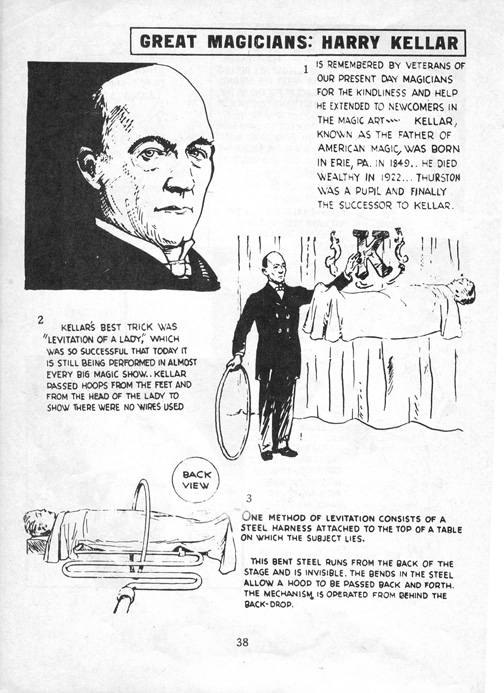 From Magic for All. The book includes 149 items in 158 pages, by chapter Tricks with a Simple Twist, Great Magicians: Their Specialties, Tricks of the Trade with a Professional Touch, Solving Card Magic, Coins with Strange Behavior, Hypnotism and Thought Transference, and Miscellaneous Tricks and Pastimes. Keen material! 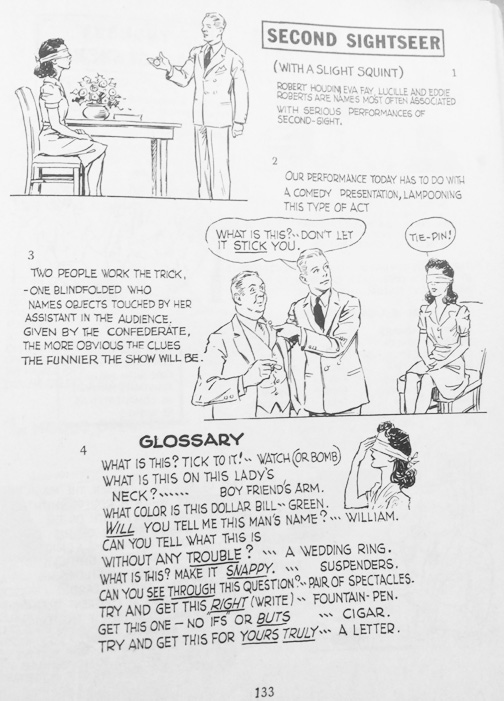 I once saw Bill and Irene do this act. Back to my cousin Billy. As a dental student he would visit our home, set up his portable drill on our kitchen table, and have at us. On one such visit I showed him a trick, the Phantom Card, which as mentioned in the Deland issue I learned from a Joseph Leeming book from the library. I had constructed the fake card fan from other cards in the deck, but unfortunately at ten years old I couldn't wait to show off my powers. The trick worked, and the thought-of cards vanished, but Billy couldn't help but notice the scissors, the snippets of playing cards, and the paste lying nearby. Lesson: Clean up your secret evidence before foisting your miracles on the public. |
|
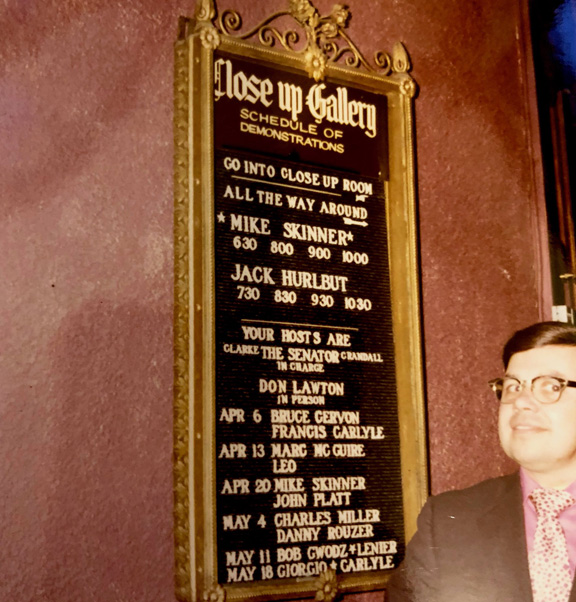 Are these guys any good?
All best wishes to Richard, Charlie, and Marshall. H&R was the best. See you down the road.
Follow us on Twitter. Little Egypt Magic is the erratically updated web site of Steve Bryant, spawned (the site, not Steve) by a former internet magazine known as The Little Egypt Gazette/for magicians only. Steve Bryant is an obscure magician and writer who generates this site from an iMac in Bloomington, Indiana. He used to frequently journey to and perform magic in Little Egypt, the local name for extreme southern Illinois, where the towns bear such names as Cairo, Thebes, and Karnak. Past issues of this web site: Index to Past Issues Notice: Any limited use of copyrighted images or quoted text is considered fair use, usually to review whatever product or event that is under discussion. If you object to use of any material, please get in touch and it will be cheerfully removed. |
A JSB Creations product
Copyright© 2019 by Steve Bryant